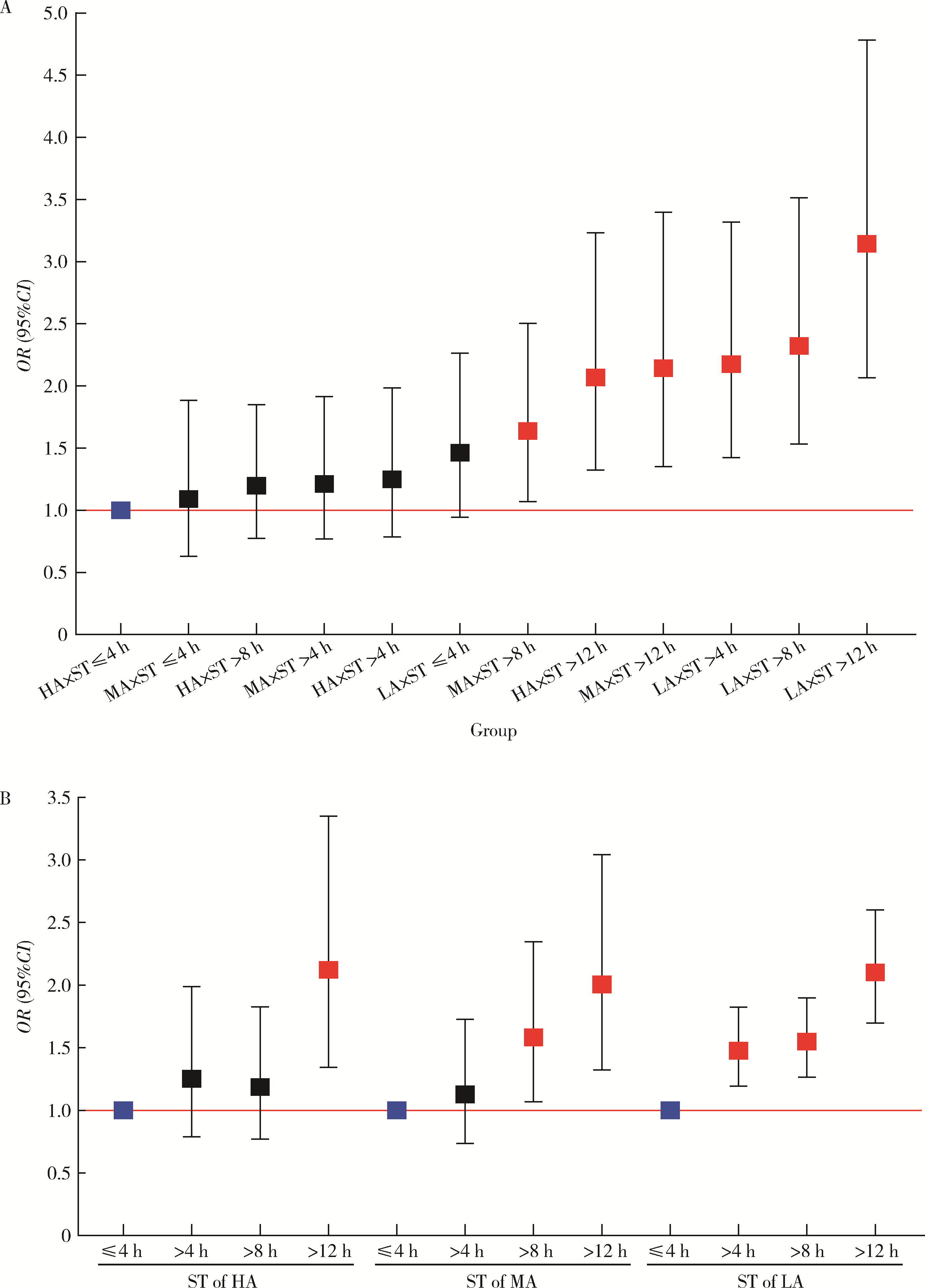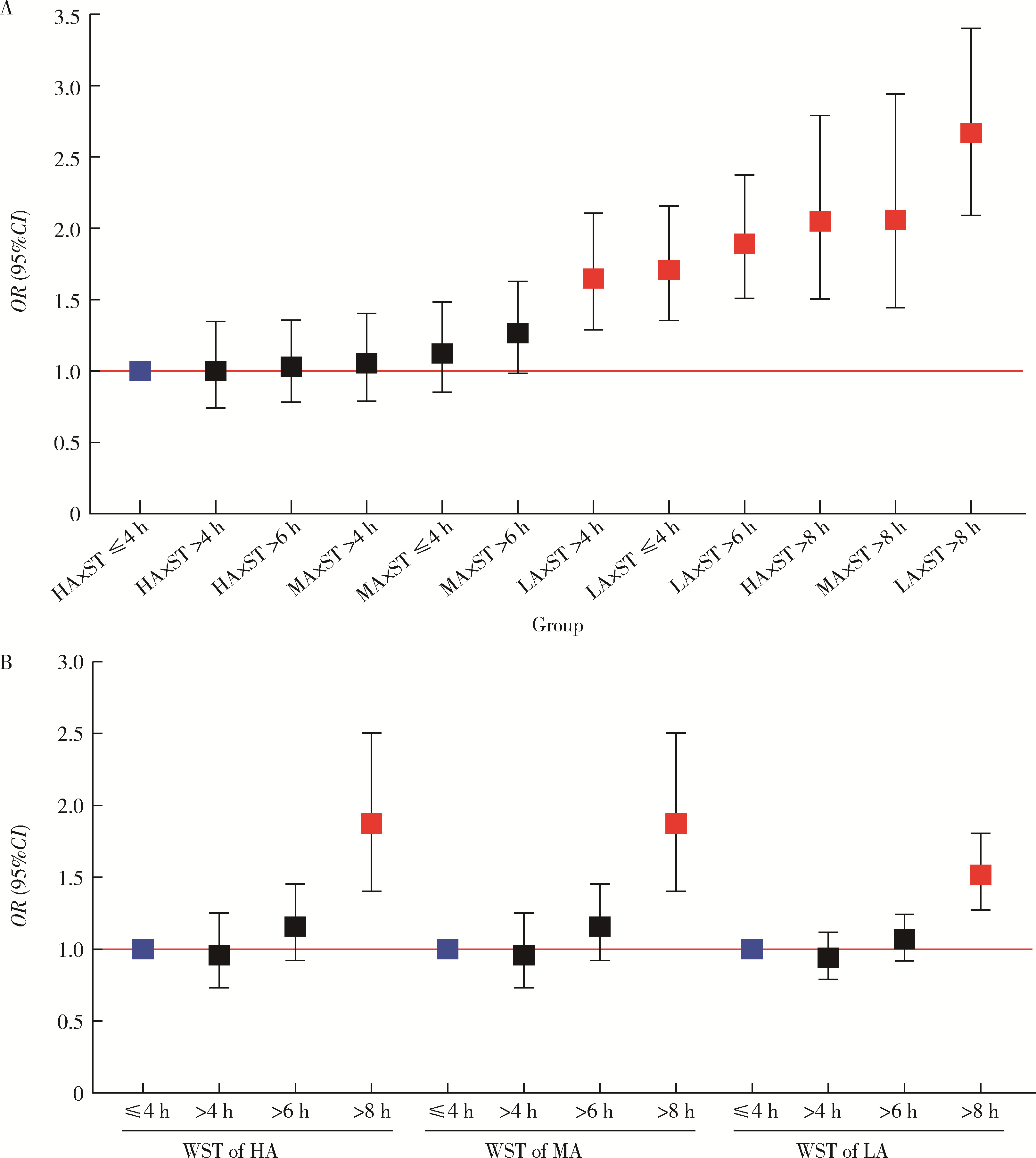北京大学学报(医学版) ›› 2022, Vol. 54 ›› Issue (3): 490-497. doi: 10.19723/j.issn.1671-167X.2022.03.014
久坐行为与体育锻炼行为对职业人群焦虑倾向的联合作用
刘熠华,云青萍,张蓝超,张晓悦,林郁婷,刘芳静,郑志杰,常春*( )
)
- 北京大学公共卫生学院社会医学与健康教育系, 北京 100191
Joint association of sedentary behavior and physical activity on anxiety tendency among occupational population in China
Yi-hua LIU,Qing-ping YUN,Lan-chao ZHANG,Xiao-yue ZHANG,Yu-ting LIN,Fang-jing LIU,Zhi-jie ZHENG,Chun CHANG*( )
)
- Department of Social Medicine and Health Education, Peking University School of Public Health, Beijing 100191, China
摘要:
目的: 探讨国内职业人群焦虑倾向现况,分析久坐行为和体育锻炼行为二者联合作用对焦虑倾向的影响。方法: 基于2021年亚洲最佳职场(中国大陆地区)的调查数据,使用广泛性焦虑障碍量表评估员工的焦虑倾向,采用Logistic回归方程分析久坐和体育锻炼对焦虑倾向的联合影响并计算不同组别之间的优势比(odds ratio, OR)。结果: 共纳入11 903名企业员工,平均年龄32.9岁;其中3 562名员工存在焦虑倾向,检出率为29.9%;40岁以下人群焦虑倾向率(30.6%)高于40岁以上人群(26.7%),两者差异有统计学意义。过去一周平均每日静坐时间为9.4 h,静坐时间超过8 h界定为久坐,久坐的比例达到76.3%。多因素Logistic回归分析结果显示,吸烟(OR=1.24,95%CI:1.23~1.39)、更长的静坐时间和更低的体育锻炼水平是员工出现焦虑倾向的危险因素,平均每日更久的睡眠时间(OR=0.56,95%CI:0.51~0.61)是其保护因素。将体育锻炼行为和静坐行为分别进行联合相关性分析和分层分析,结果显示静坐时间增加与体育锻炼水平减少相结合会导致焦虑倾向风险的显著增加,随着体育锻炼水平的增加,静坐时间作为焦虑倾向危险因素的阈值逐渐下降。结论: 本次调查职业人群焦虑倾向的检出率较高且久坐行为严重,缺乏体育锻炼与久坐行为均是焦虑倾向的独立危险因素,加强体育锻炼可以在一定程度上弥补久坐行为对焦虑倾向带来的危害。
中图分类号:
- R131
| 1 |
Charlson FJ , Baxter AJ , Cheng HG , et al. The burden of mental, neurological, and substance use disorders in China and India: A systematic analysis of community representative epidemiological studies[J]. Lancet, 2016, 388 (10042): 376- 389.
doi: 10.1016/S0140-6736(16)30590-6 |
| 2 | 健康中国行动推进委员会. 健康中国行动(2019—2030年)[EB/OL]. (2019-07-15)[2020-11-20]. http://www.gov.cn/xinwen/2019-07/15/content_5409694.htm. |
| 3 |
Dewa C , Lesage A , Goering P , et al. Nature and prevalence of mental illness in the workplace[J]. Healthc Pap, 2004, 5 (2): 12- 25.
doi: 10.12927/hcpap..16820 |
| 4 |
Schuch FB , Vancampfort D , Firth J , et al. Physical activity and incident depression: A meta-analysis of prospective cohort studies[J]. Am J Psychiatry, 2018, 175 (7): 631- 648.
doi: 10.1176/appi.ajp.2018.17111194 |
| 5 |
Kandola A , Ashdown-franks G , Stubbs B , et al. The association between cardiorespiratory fitness and the incidence of common mental health disorders: A systematic review and meta-analysis[J]. J Affect Disord, 2019, 257, 748- 757.
doi: 10.1016/j.jad.2019.07.088 |
| 6 |
Clemes SA , Oconnell SE , Edwardson CL . Office workers' objectively measured sedentary behavior and physical activity during and outside working hours[J]. J Occup Environ Med, 2014, 56 (3): 298- 303.
doi: 10.1097/JOM.0000000000000101 |
| 7 |
Kroenke K , Spitzer RL , Williams JB , et al. Anxiety disorders in primary care: Prevalence, impairment, comorbidity, and detection[J]. Ann Intern Med, 2007, 146 (5): 317- 325.
doi: 10.7326/0003-4819-146-5-200703060-00004 |
| 8 |
Sedentary Behaviour Research Network . Standardized use of the terms "sedentary" and "sedentary behaviours"[J]. Appl Physiol Nutr Metab, 2012, 37 (3): 540- 542.
doi: 10.1139/h2012-024 |
| 9 | Bartholomew LK , Markham CM , Ruiter RAC , et al. Planning health promotion programs: An intervention mapping approach[M]. San Francisco: Jossey-Bass, 2016. |
| 10 | 吕燕宇, 姜红如, 张兵, 等. 中国四省18~60岁职业人群抑郁情绪现状及其影响因素[J]. 环境与职业医学, 2020, 37 (5): 427- 432. |
| 11 |
Richardson S , Mcneill A , Brose LS . Smoking and quitting beha-viours by mental health conditions in Great Britain (1993-2014)[J]. Addict Behav, 2019, 90, 14- 19.
doi: 10.1016/j.addbeh.2018.10.011 |
| 12 |
姜学文, 鞠巍, 常春. 职业人群焦虑和抑郁状况与工作环境的通径分析[J]. 中国心理卫生杂志, 2019, 33 (5): 375- 380.
doi: 10.3969/j.issn.1000-6729.2019.05.012 |
| 13 |
Patterson R , Mcnamara E , Tainio M , et al. Sedentary behaviour and risk of all-cause, cardiovascular and cancer mortality, and incident type 2 diabetes: A systematic review and dose response meta-analysis[J]. Eur J Epidemiol, 2018, 33 (9): 811- 829.
doi: 10.1007/s10654-018-0380-1 |
| 14 |
Park JH , Moon JH , Kim HJ , et al. Sedentary lifestyle: Overview of updated evidence of potential health risks[J]. Korean J Fam Med, 2020, 41 (6): 365- 373.
doi: 10.4082/kjfm.20.0165 |
| 15 | 艾磊, 罗维, 鹿琦, 等. 不同体型成年人在平躺、久坐、睡眠和运动状态下代谢当量与能耗的比较研究[J]. 成都体育学院学报, 2021, 47 (3): 106- 112. |
| 16 |
Zhai L , Zhang Y , Zhang D . Sedentary behaviour and the risk of depression: A meta-analysis[J]. Br J Sports Med, 2015, 49 (11): 705- 709.
doi: 10.1136/bjsports-2014-093613 |
| 17 |
Kraut R , Patterson M , Lundmark V , et al. Internet paradox: A social technology that reduces social involvement and psychological well-being?[J]. Am Psychol, 1998, 53 (9): 1017- 1031.
doi: 10.1037/0003-066X.53.9.1017 |
| 18 |
Spittaels H , Cauwenberghe EV , Verbestel V , et al. Objectively measured sedentary time and physical activity time across the lifespan: A cross-sectional study in four age groups[J]. Int J Behav Nutr Phys Act, 2012, 9, 149.
doi: 10.1186/1479-5868-9-149 |
| 19 |
Colley RC , Garriguet D , Janssen I , et al. The association between accelerometer-measured patterns of sedentary time and health risk in children and youth: Results from the Canadian Health Measures Survey[J]. BMC Public Health, 2013, 13, 200.
doi: 10.1186/1471-2458-13-200 |
| 20 |
Stamatakis E , Gale J , Bauman A , et al. Sitting time, physical activity, and risk of mortality in adults[J]. J Am Coll Cardiol, 2019, 73 (16): 2062- 2072.
doi: 10.1016/j.jacc.2019.02.031 |
| [1] | 赖金惠,王起,姬家祥,王明瑞,唐鑫伟,许克新,徐涛,胡浩. 新型冠状病毒肺炎疫情期间延迟拔除输尿管支架对泌尿系结石术后患者生活质量和心理状态的影响[J]. 北京大学学报(医学版), 2023, 55(5): 857-864. |
| [2] | 袁雯,张奕,陈力,蒋家诺,陈曼曼,刘婕妤,马涛,马奇,崔孟杰,郭桐君,王鑫鑫,董彦会,马军. 儿童青少年身体脂肪分布与抑郁和社交焦虑的关联:基于双能X线检测的横断面研究[J]. 北京大学学报(医学版), 2023, 55(3): 429-435. |
| [3] | 王一帆,范稹,成姚斌,金月波,霍阳,何菁. 原发性干燥综合征患者睡眠障碍的相关影响因素[J]. 北京大学学报(医学版), 2020, 52(6): 1063-1068. |
| [4] | 耿研,宋志博,张晓慧,邓雪蓉,王昱,张卓莉. 银屑病关节炎抑郁和焦虑患病情况及相关因素[J]. 北京大学学报(医学版), 2020, 52(6): 1048-1055. |
| [5] | 易端,朱薇,孟秀丽,刘晓光,李水清,祝斌,贾东林. 慢性腰腿痛患者微创术前焦虑,抑郁状态及相关影响因素分析[J]. 北京大学学报(医学版), 2020, 52(2): 285-289. |
| [6] | 王天骄,刘宇,关明. 咪达唑仑联合丙泊酚靶控输注静脉镇静对拔除下颌第三磨牙患者焦虑水平的影响[J]. 北京大学学报(医学版), 2017, 49(6): 1044-1049. |
| [7] | 雷杰,刘木清,傅开元. 睡眠问题、焦虑及压力是颞下颌关节紊乱病肌筋膜疼痛发病的风险指标[J]. 北京大学学报(医学版), 2016, 48(4): 692-696. |
| [8] | 程兰,李钦,宋逸,马军,王海俊. 中国9~11岁小学生体育锻炼、静态行为和#br# 超重与肥胖的关系[J]. 北京大学学报(医学版), 2016, 48(3): 436-441. |
| [9] | 韦冬梅, 吴丽晶, 高爱钰, 李钦, 程兰, 王海俊. 儿童视屏行为和家庭相关因素与儿童体重指数的关系[J]. 北京大学学报(医学版), 2015, 47(3): 390-394. |
| [10] | 张红梅, 夏斌, 王建红, 陈小贤, 葛立宏. 全身麻醉和束缚牙科治疗对不合作患儿牙科焦虑水平的影响[J]. 北京大学学报(医学版), 2015, 47(1): 134-139. |
| [11] | 张凯, 贺利军, 虞巍,王弋, 白文俊, 王晓峰, 朱积川, 金杰, 那彦群 . 22~50岁中国人精神心理健康状况与下尿路症状及阴茎勃起功能障碍的相关性[J]. 北京大学学报(医学版), 2013, 45(4): 609-. |
| [12] | 汤淑女, 简伟研. 中国就业人群慢性病的社会决定因素[J]. 北京大学学报(医学版), 2013, 45(03): 443-447. |
| [13] | 宋逸, 张芯, 杨土保, 张冰, 董彬, 马军. 2010年全国中小学生体育锻炼行为现状及原因分析[J]. 北京大学学报(医学版), 2012, 44(3): 347-354. |
| [14] | 刘童童, 王生, 何丽华, 叶康平, 许迎春, 张菲若 . 工频磁场慢性暴露对大鼠神经行为的影响[J]. 北京大学学报(医学版), 2010, 42(3): 351-355. |
| [15] | 葛立宏. 儿童口腔科治疗中的焦虑和疼痛控制[J]. 北京大学学报(医学版), 2009, 41(1): 6-9. |
|
||




